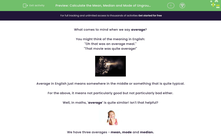What comes to mind when we say average?
You might think of the meaning in English:
"Oh that was an average meal."
"That movie was quite average!"

Average in English just means somewhere in the middle or something that is quite typical.
For the above, it means not particularly good but not particularly bad either.
Well, in maths, 'average' is quite similar! Isn't that helpful?

We have three averages - mean, mode and median.
They all describe what we can typically expect if we picked a data point from a set, i.e. what the data tends to be.
That's why we call mean, mode and median measures of central tendency! Well, some of us might!

Mean is the arithmetic average.
We get it by adding all the numbers together and dividing that by how many numbers we have.
For example, for numbers: 11, 4, 7, 10, 8, 7, 2
We first add the numbers together:
11 + 4 + 7 + 10 + 8 + 7 + 2 = 49
Altogether we have seven numbers.
So the mean is 49 ÷ 7 = 7
.jpg)
Median is the middle number.
To find it, we always need the data in order (from the smallest to the largest or vice-versa).
We then get the median by crossing one number from each side at a time until we are left with one number in the middle.
For example, for the same numbers: 11, 4, 7, 10, 8, 7, 2
We first order them: 2, 4, 7, 7, 8, 10, 11
Then we cross one number from each side at a time until we have one number left:
2, 4, 7, 7, 8, 10, 11
2, 4, 7, 7, 8, 10, 11
2, 4, 7, 7, 8, 10, 11
So the median is 7!
Finally, we have mode.
Mode is the most frequent data point.
To find it, we just look at what data point occurs the most often!
We can order the data to make it a bit easier to spot if we want to but it's not necessary.
For example, for the same numbers 11, 4, 7, 10, 8, 7, 2
We can see that all numbers are there once except 7, which is there twice.
So the mode is 7!
Mode is also the only average we can find when we have qualitative rather than quantitative data.
Quantitative data are essentially just numbers - qualitative data is anything but numbers!
For example, if 8 students were asked for their favourite colour and these were the responses:
red, purple, blue, blue, pink, red, blue, yellow
This is an example of qualitative data.
We can see that the colour that appears the most number of times (3 times) is blue.
So the mode here is 'blue'!

Let's have a look at just one more example:
The heights (in cm) of students in a class are recorded as follows: 140, 142, 150, 152, 153, 155, 141, 139
Find the mode and median.

To find the mode, we want the most frequent number.
But what's that?
Here, every number appears the same number of times (once).
So there is no mode.
For the median, we first order the numbers:
139, 140, 141, 142, 150, 152, 153, 155
Then crossing one number from each side at a time, we get:
139, 140, 141, 142, 150, 152, 153, 155
Here we ended up with two numbers in the middle.
When this happens, we take the mean of these two numbers to get the median.
Adding the two numbers first, we get 142 + 150 = 292
Dividing that by how many numbers we added (2), we get our median:
292 ÷ 2 = 146

Ready to put all this into practice?








